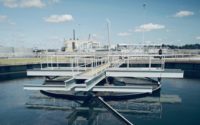The U.S. Environmental Protection Agency announced another $2.4 billion awarded to states from the Infrastructure Investment and Jobs Act for clean water projects.
This is the second wave of funding from the law being distributed through the clean water State Revolving Fund (SRF) program to support upgrades of water, wastewater and stormwater infrastructure. EPA previously announced $1.9 billion for states through the program last May.
Overall, the agency plans to distribute $44 billion to states, territories and tribes for water infrastructure projects through SRFs over five years.
New York will receive the largest share of the latest allotment, with $232.4 million, records show. California ranks second with $150.6 million, followed by Ohio with $118.5 million, Texas with $96.2 million and Illinois with $95.2 million.
EPA Administrator Michael Regan called the infrastructure law funding “an unprecedented investment” to revitalize water infrastructure across the country. Nearly half of the money is available as grants and forgivable loans.
“Not only will these funds expand access to clean water and safeguard the environment, but more underserved communities that have been left behind for far too long will be able to access them,” he said.
In New York, officials have already used money from the first wave of funding for improvements to the Newburgh combined sewer overflow system, addressing discharge of untreated sewage into the Hudson River during storms. The first phase of work on the project involves building 8,500 ft of new interceptor sewer ranging from 18 in. to 4 ft in diameter.
Maureen Coleman, president and CEO of the New York State Environmental Facilities Corp., which administers state SRF money, said it has also helped modernize water systems in Albany and Liberty. She says the state is targeting small, rural and disadvantaged communities for this new round of funding.
EPA also announced another $225 million to supplement clean water SRF funding for emergency contaminants, aimed at projects to specifically address those known or anticipated in the environment, such as microplastics, which may pose risks to human health or aquatic life.
Officials also said EPA would announce allocations for drinking water SRFs this month.






Post a comment to this article
Report Abusive Comment